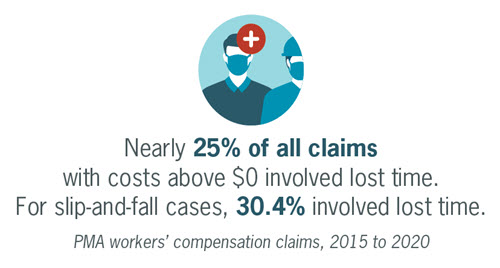Safety Awareness – 5 Steps to an Effective Post-Injury Return-to-Work Program
Posted on 07/15/22 by PMA Companies
It is a sobering statistic: at least four million Americans have quit their jobs every month since July 2021 (Bureau of Labor Statistics, March 2022). There is no hard and fast “why,” because reasons run the gamut from employees finding better opportunities to early retirement.
This environment has been difficult for employers as they have lost seasoned workers and attempted to source and hire new employees. First-year employees are historically known to report more workers’ compensation claims. In addition, operating with fewer workers may add to employee workloads, require longer work hours, and consequently lead to more injuries.
Building a Dedicated Return-to-Work Team
The goal of a workers’ compensation safety program is to keep employees safe and prevent workplace accidents. However, if a worker is injured and is facing a restriction, a return-to-work program, with a dedicated team, is essential to post-injury management.
Five Steps for a Post-Injury Management Program
The following steps outline PMA Risk Control’s suggestions for effective post-injury management—from injury occurrence to return to work.
1 EMPLOYEE/EMPLOYER COMMUNICATION Be compassionate and understanding with an injured worker. An employee who feels taken care of and knows your organization wants them back is more likely to return as a productive employee. Ongoing communication with the employee helps to ensure their adherence to the Post-Injury Management Program and reduces the potential for longer than necessary work absences.
An injured employee may feel isolated and concerned about their future. Periodic contact by a company representative with whom the employee is familiar can help allay these concerns and prevent small irritations from growing into a litigious and protracted confrontation. Consider the following timetable for contact:
- Initial contact within 24-48 hours after the injury
- First four weeks post-injury—contact weekly
- After four weeks—contact biweekly or after each significant physician’s appointment
- Post-return to work—supervisor check-ins during the first and second work week
2 CLAIMS REPORTING The employer should immediately report all claims to PMA either online, by phone or by fax. Prompt notification to PMA helps to achieve the following:
- Timely employee contact and investigation
- Prompt determination of medical and indemnity benefits
- Prompt management of medical and indemnity costs
- Reduced frequency and litigation costs
- Enhanced employee satisfaction
Studies have indicated that claims reported more than three days after the occurrence have an increased potential for litigation. This can be due to employee frustration with the claims process, such as their pay being interrupted or not receiving the necessary medical attention. Therefore, they are more apt to hire an attorney to help meet their needs.
3 REFERRAL TO PHYSICIAN Your company should use a PMA preferred provider whenever possible to help manage workers’ compensation costs. Your claims professional can help you with this. When an injured employee visits a medical provider, they should bring the Physician’s Packet, which includes the following documents:
Letter of Introduction to the Physician: Indicates you have a Post-Injury Management Program, including Return-to-Work options, and will attempt to accommodate any necessary work restrictions.
Physician’s Work Status/Physical Capabilities Form: This form indicates whether the employee can return to work at full capacity or with physical restrictions. The physician must complete this form at the initial office visit. The employee should be responsible for returning it to their employer, if they are capable. This will allow you to speak directly with the employee. The employer should send the work status form to PMA promptly.
Employee’s Job Description: The physician needs this to determine if the injured employee can return to work. Without it, the physician cannot properly assess if the injured employee will be able to perform the job (or if they’ll need accommodations).
4 IDENTIFY WORK AND FOLLOW-UP The goal is to avoid lost time, or facilitate return to work as soon as is medically feasible to:
- The pre-injury job if medically capable (full-duty work)
- The employee’s pre-injury job with reasonable accommodations (modified-duty work). Modified duty is an excellent way to provide a smooth and gradual return to work that helps you to monitor the injured employee’s recovery.
- A different job until the employee is physically able to return to their pre-injury job (transitional duty work)
5 RE-JOINING THE WORKFORCE Facilitate an injured employee’s transition to the workforce as soon as is medically appropriate. Before the worker starts a modified or transitional position, the supervisor and employee should review the job together, including all job duties and limitations set by the treating
physician. The supervisor should emphasize that the worker needs to remain within these limitations.
Workers should report any physical difficulties immediately to their supervisor and stop performing the work. Once the physician determines that the injured employee is physically capable of returning to full capacity, a signed Physician’s Work Status/Physical Capabilities Form should be received by the designated representative, such as Human Resources, prior to the employee returning to their pre-injury job.
Navigating through these challenging times can be difficult. However, keeping employees safe and ensuring they can return to work if injured will help your organization thrive. PMA Risk Control is ready to partner with you to reduce risk and help minimize the impact of accidents.
Additional Related Resources Available on PMA WEBSOURCE
Organizational Safety Solutions — Post-Injury Management
PMA's Return-to-Work and Post-Injury Management Program Implementation Guide
If you have any questions or would like additional information, please contact your local PMA Risk Control Consultant or reach out to us at heretohelp@pmagroup.com.
IMPORTANT NOTICE
The information and suggestions presented by PMA Companies in this risk control technical bulletin are for your consideration in your loss prevention efforts. They are not intended to be complete or definitive in identifying all hazards associated with your business, preventing workplace accidents, or complying with any safety related or other laws or regulations. You are encouraged to alter the information and suggestions to fit the specific hazards of your business and to have your legal counsel review all of your plans and company policies. PMA Companies and Old Republic Companies do not provide legal advice and the information and suggestions in this bulletin should not be considered as such.

